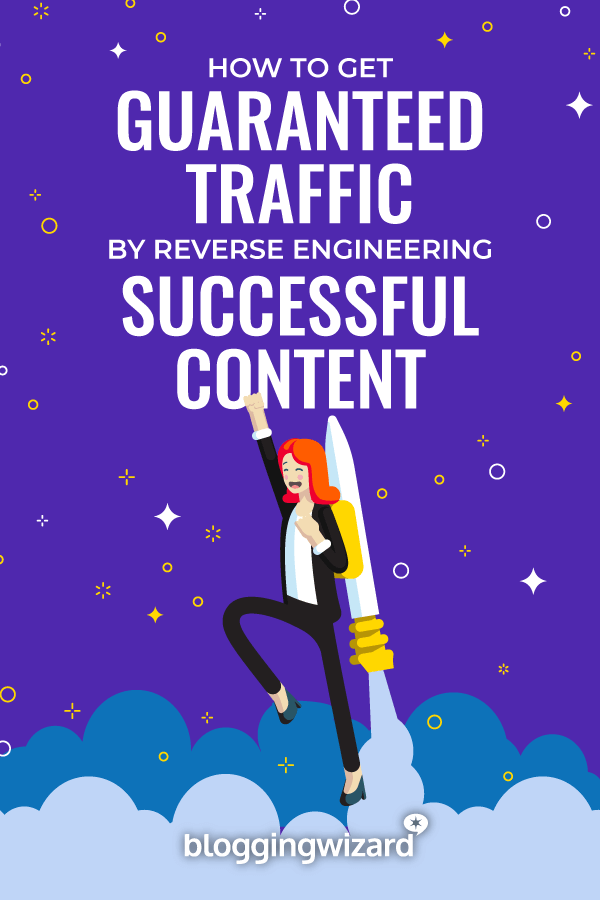How To Get Guaranteed Traffic By Reverse Engineering Successful Content

Thousands of bloggers across the world are guilty of making the same deadly mistake.
… a mistake that derails the growth of most blogs before they’ve had chance to reach their full potential.
In fact, there is a big chance you’re guilty of making this mistake as well.
That’s not a bad thing. I made the same mistake.
Can you guess what this mistake is called?
Originality.
Creating highly original content sounds great. You create something creative and original. Then, people will reward you with shares and links.
At least that’s what it sounds like on paper.
In truth, if you create only original content, most of your efforts will fail. You’ll spend far too much time (and money) creating content with no guarantee of success.
The solution? Reverse engineer what’s already working and make it even better.
In this post, I’m going to show you exactly how.
Let’s get started:
The 80/20 rule of content creation
The 80/20 rule (or Pareto’s Principle) holds true for most things, including content creation.
It’s a simple rule:
80% of your content should be based off already successful content. The remaining 20% should be original pieces.
Note: You may want to tweak this slightly depending on the growth stage of your blog. Original content can be more effective once you have a larger audience. But, it’s a good starting point.
For example, if you know that lengthy list based posts seem to do well for your competitors, your next article should have a similar style and structure.
After publishing four of these posts, you can add in an original op-ed article covering a controversial issue in your niche.
For the reverse engineering process to be successful, you need to follow 3 steps:
- Figure out what content performs well in your niche
- Analyze the content to find out what makes it successful
- Use these findings to inspire your own content
Let’s dive deeper into each of these three steps:
Step #1: Figure out what content is already successful in your niche
The first step in the reverse engineering process is to find already successful content to model your posts on.
There are four tactics you can use:
1. The social media method
This one is fairly obvious – anything that gets a lot of shares on social media gives you a good foundation to base your content on.
A quick and easy way to do this is to use a tool like ContentStudio.
For example, if you were writing an article on “time management,” you could look up this keyword in ContentStudio and see the best performing content on different social networks.
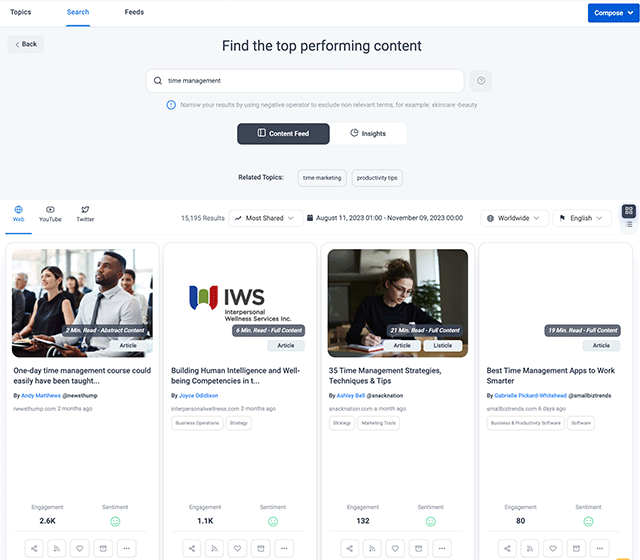
You can then open up an analysis of the topic for a top-level overview, like this:
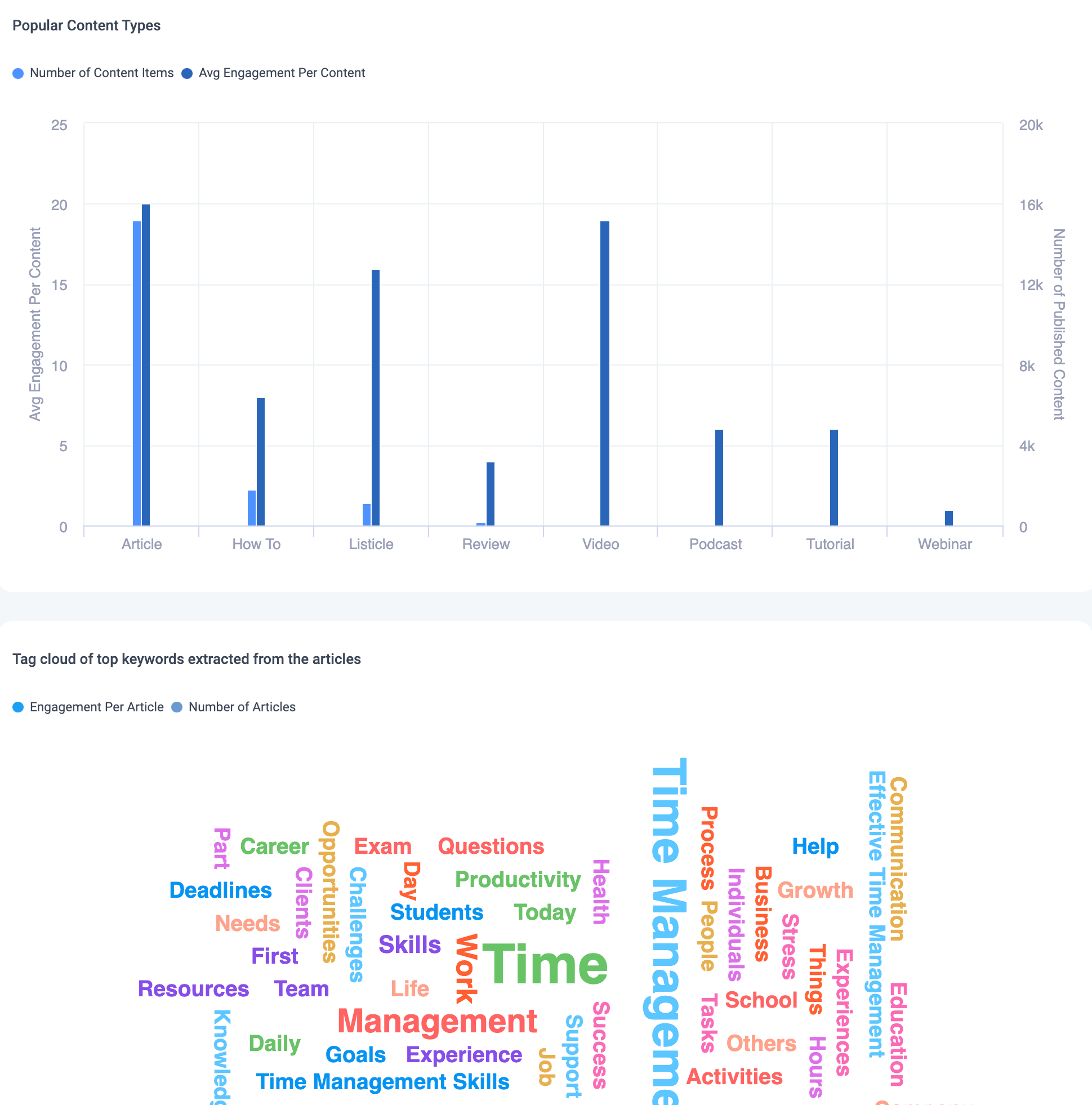
Amongst other things, this report will give you an idea of the types of content that perform well and popular keywords.
The key takeaways from this process are the types of content, types of articles, and headlines that perform well on social media.
If you have a specific competitor who is doing particularly well on social media, you can plug their domain into ContentStudio as well to see their top performing content.
2. The search engine method
This method is simple: search for your target keywords and see what content is ranking at the top of the SERPs.
For example, if your target keyword was “marketing tactics,” here’s what Google might tell you:
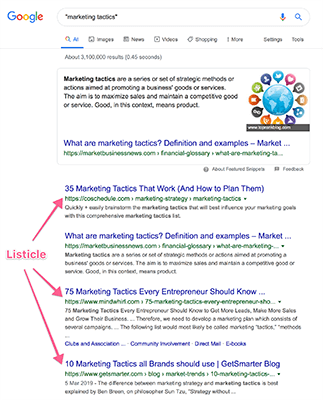
Note: Google may show you something different because search results are personalised based on various factors such as location.
Track the results for different keywords in a separate Google Sheet for future planning sessions.
Here’s what you need to track:
- The keyword
- Headline + post type (1st result)
- Headline + post type (2ndresult)
- Headline + post type (3rd result)
3. The Reddit method
Reddit is one of the most popular websites in the US and the self-described “front page of the internet.”
Not only is Reddit a great source of traffic, it is also an excellent platform for conducting content research.
Start by searching for your keyword using Reddit’s search function. For example, if you were writing about “marketing tactics,” searching for this keyword would show you a bunch of sub-Reddit’s for marketing…
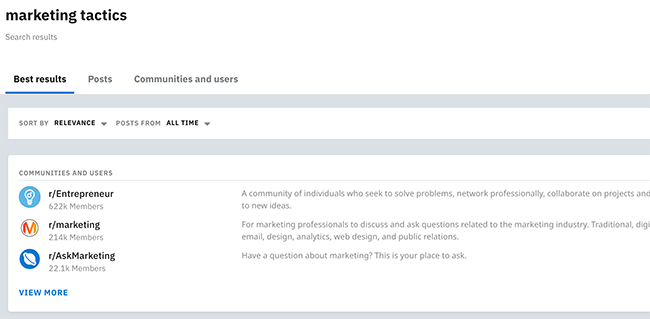
… and a bunch of posts relating to “marketing tactics.”
Within that list of posts relating to marketing tactics, you will undoubtedly find some useful content ideas.
You could also visit some of the recommended sub-Reddit’s and sort by the “Top” posts and adjust the date filter to within the last month/year.
4. The niche-platform method
This doesn’t apply to every industry, but a great way to find top content is to browse industry-specific sharing platforms.
For example, marketers have the likes of GrowthHackers.com.
Just looking at their posts page, we can see what sort of content works well in the marketing space:
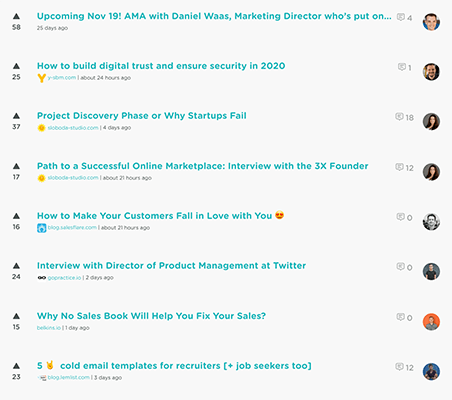
In the tech field, your go-to niche sharing site would be Hacker News. Go to Hacker News’ “Best of” links to see top performing content:

Here are a bunch of other niche sharing platforms:
- ManageWP.org – WordPress
- N4G.com – Gaming
- FilmWatch.com – Movies
- DesignerNews.co – Design
If these don’t align with your niche, be sure to check out content aggregators such as AllTop and Flipboard.
And, be sure to create a separate spreadsheet to collect all the top content you find.
Step #2: Figure out what makes each piece of content successful
This is the hard part – figuring out what makes each piece of content work.
There are three key things you should look at here:
1. The headline
You probably already know that headlines are super important.
According to legendary copywriter, David Ogilvy: “5 times as many people read the headline as read the body copy.”
Analyzing the headlines used by your top performing content can give you a world of insight into what makes them tick.
For example, let’s take another look at the top performing content on GrowthHackers.com (minus the AMA at the top):
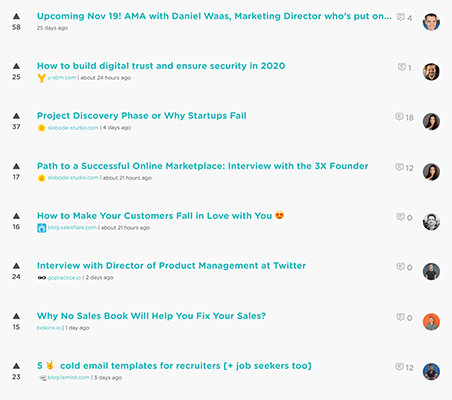
You can see why they work:
- The fourth post is immediately shows what readers will learn, and is backed up by “The 3x Founder” which establishes credibility.
- The second to last post creates curiosity by sharing a statement that flies in the face of what most people believe.
Here are a few questions to ask yourself when you analyze any headline:
Does the headline use curiosity or hyperbole?
Hyperbole, curiosity, confessions … these are all weapons writers can use to hook readers in.
You’ve seen these headlines all over social media – headlines that promise to show you things “you won’t believe,” or spill the “secrets of…” something.
Here are some things to consider:
- Spark curiosity – Your headline should leave an unanswered question. For example, instead of making a statement you could flip the headline around into a question.
- Find the right balance of hyperbole – Some headlines require some level of hyperbole to work but don’t over-do it. Your headline is a promise and your content needs to deliver.
Does the headline use numbers?
Headlines with numbers tend to perform better than ones that don’t.
For example: “6 ways to find [blank],” and “10 recipes to [blank],” etc.
These headlines work because they give readers a firm idea of what to expect from the article. List-based headlines are also easy to read visually.
And, Buzzfeed’s top performing articles on Facebook usually have a number in them. It doesn’t matter whether the number is low (e.g. “18 Photos That Won’t Make Sense To Sisterless Families”) or extremely high (“61 Best Teacher Memes”) – the effect seems to be similar.
Listicles don’t just perform well on social media – they also perform well in organic search.
Here’s an example: when searching for “SEO techniques” – 4 out of 5 of the top results are listicles.
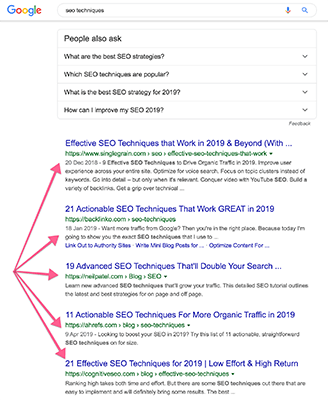
And the same goes for plenty of other search terms.
Does the headline use any power words?
Words like “mind-blowing”, “secret”, “banned” are called power words. They’re words that jump out at you because they’re not used in everyday speech.
(Seriously: ask yourself – when was the last time you use the word “secret” with your friends?)
Most top-performing headlines use power words like these to grab attention.
Sites like Upworthy.com frequently use power words in headlines. Here’s an example:

The words “hauntingly beautiful” immediately attract the reader’s attention and spark strong emotions. The music isn’t just beautiful, it’s hauntingly beautiful.
So, analyze the headlines used by the successful articles you discovered in step #1. You can then start using this data in your own content.
Which brings us to the next piece of the puzzle: the content.
2. Content
This is the meat and potatoes of any successful post. Sure, a great headline will get people onto your website, but unless it is backed by solid content, it won’t win you any favors with readers.
Here are a few questions you should ask when analyzing content from step #1:
How long is the content?
You’ve probably seen studies showing a positive correlation between content length and SEO, like this one from serpIQ (source is no longer live):
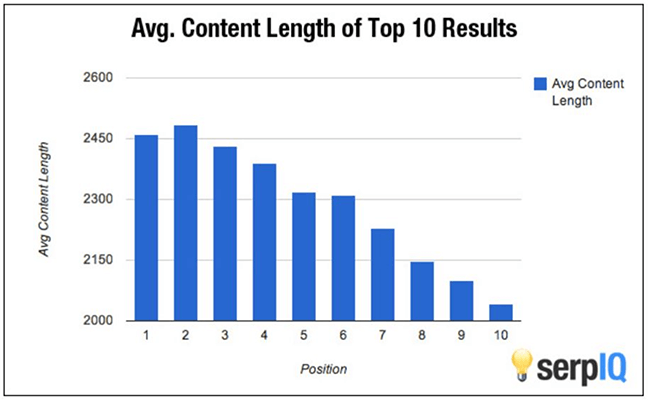
And studies that show a correlation between content length and total social shares:
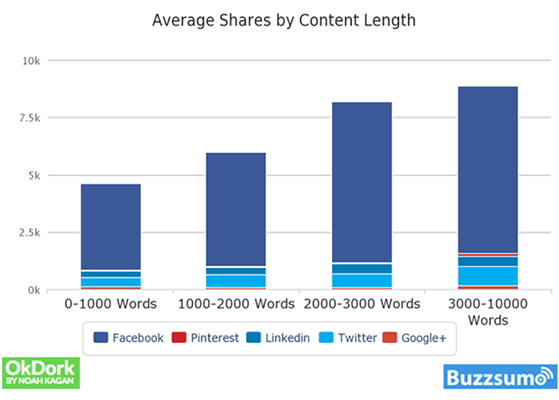
In order to determine the ideal length of a blog post, Medium did a study where they measured content that performs best based on the reader’s attention not on clicks.
They worked out that the ideal length of a blog post is 7 minutes or 1,600 words.

Content length tells you whether the author went in-depth into a piece of whether they just skim the surface.
This is an important point to understand when you reverse engineer successful content.
Note: Just because a study says long-form content is better, doesn’t mean it is. These are correlation studies and correlation doesn’t always equal causation. So, be sure to consider user intent (or search intent in the case of SEO) when you evaluate content length. Typically, content should be as long as it needs to in order to get the message across.
Is the content highly visual?
According to Visual Learning Alliance, visuals are processed 60,000x faster in the brain.
We know that:
How a piece of content uses visuals often has a big role to play in its success.
A couple of things you should look out for:
1. Images
Images in any post perform three functions:
- Illustrative: They show the reader what the post is trying to say.
- Structural: Images help you structure and organize the content.
- Emotional: Images reflect and amplify the emotions in any content.
You ideally want to use images for both showing (and not just telling) your readers, and for organizing your content.
For example, one of Gizmodo’s top performing articles uses images to show what something looks like:

Whereas, Backlinko uses images not only to show you what something looks like, but also to organize the content into digestible chunks:
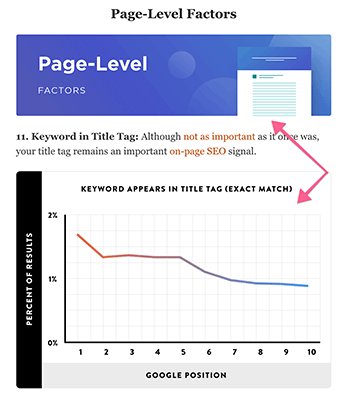
Images are also a great way to convey emotions you want your readers to feel. Seeing an image of a happy person makes us happy and a sad image makes us sad. Use this to your advantage by using appropriate images.
This is a tactic often used in landing pages, but works just as well in blog posts.
For example, in this article on “content marketing lies” Joel Klettke illustrates his emotion with an image:
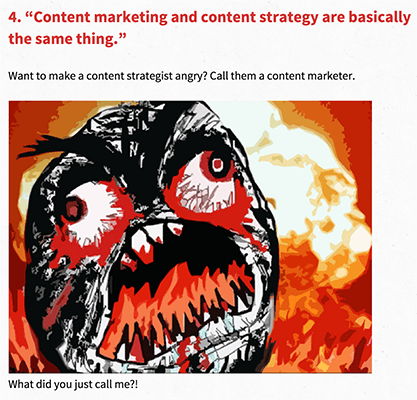
2. Videos
For some time now, video has been considered the future of content marketing. And, a study by Moz shows that videos receive nearly 300 percent more inbound links.
Personally, I prefer written content to video but there’s no doubt that video is one of the best content types to use.
Videos work best when you need to show a solution to a problem. You can add various types of videos to your platform; how-to videos, animated explainer videos, demonstrations or customer testimonials.
For example, REI sells outdoor equipment. They make how-to videos for their customers like this one on how to pack a backpack:
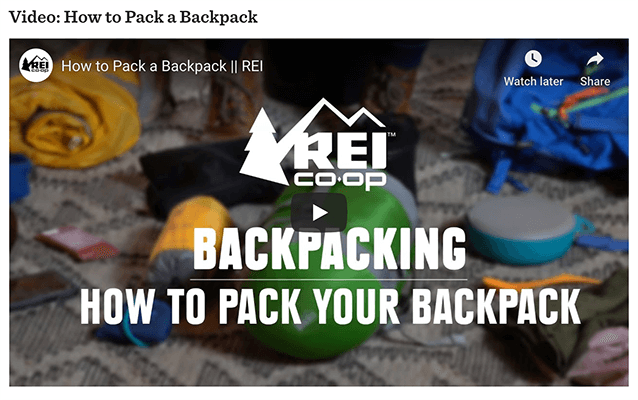
Note: As we discussed earlier, most people are visual learners. That’s one of the factors that makes videos so powerful. But when videos are structured as “talking head” style videos, that’s audible learning, not visual learning. So if you consider this style of video, consider including some visuals to convey your message more effectively to visual learners.
3. GIFs

GIFs capture user attention like no other visual content. Use of GIFs has skyrocket in recent years.

They are not limited to Reddit or social media anymore. Billion dollar companies like Buzzfeed are using GIFs in their content…
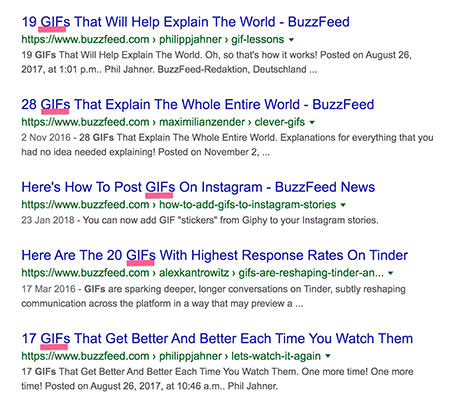
Even Pulitzer-Prize winning publishers like Washington Post are getting in on the trend and have been for years:

When analyzing content, this is another thing you should make note of.
Which brings us to the next point: readability.
How readable is the content?
We don’t need a study to tell us that people prefer sentences written in a clear and simple way.
Readability plays a big role in the success of any content. As you will see time and again, content with short sentences, simple paragraph structures and clear writing style consistently outperforms busy, complex content.
For example, on my personal blog, I rarely publish visual content and yet the content is still very readable and organized:
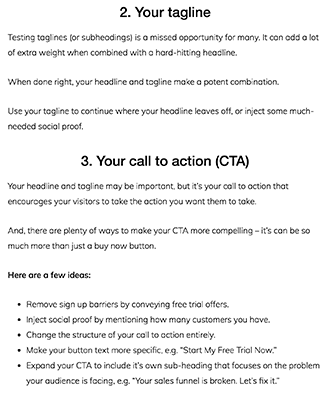
So, be sure to consider this when analyzing (and creating your own) content.
On a related note, if you need help with this type of thing, be sure to check out our article on how to format blog posts.
This brings us to the third, and arguably, the most important element in the success of any content – the distribution.
3. The distribution
Distribution is key for the success of any content you publish. Simply hitting the publish button and dropping a single tweet isn’t going to be enough. No matter how good your content is.
You need to reach the right audience.
To figure out how successful content reaches its audience, you need to figure out which distribution channels it leverages.
Let me show you how to do this with an example.
Digging through Copyblogger’s post on “SEO for Modern Content Marketers,” we can see its distribution channels by asking these questions:
How many social shares did the content get (and from what channel)?
Note: This question is less important than it was a couple of years ago. At least, it’s more difficult to answer. Uncovering accurate share counts is more challenging and the few tools that do it well are expensive. I’m leaving this question in the article for completeness but you may want to skip to the next one.
Searching the article on BuzzSumo gives the total number of shares on social media.

This post has a total of 2,400 shares with most shares coming from Facebook and Twitter. This tells us roughly where their target audience is most active.
As a side note, I’d guess that a core segment of their target audience is on LinkedIn but share counts for that platform aren’t available since their API was shut down.
What kind of social media following does the website have?
Figuring out a publisher’s social following can give you insight into what social channels you should focus on.
It is evident by looking at Copyblogger’s Twitter following that they’ve focused their marketing efforts on Twitter.
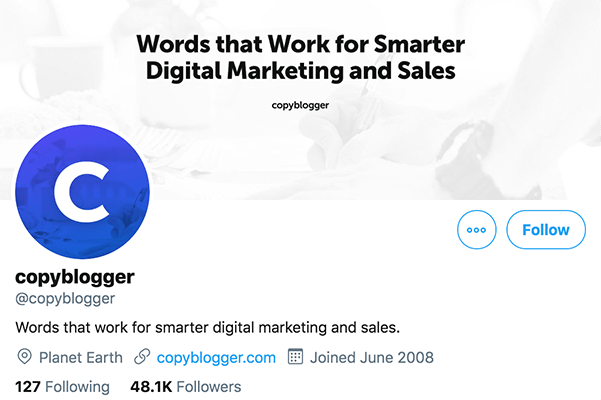
With their Facebook page clocking in at around 35,000 followers.
How many backlinks does the content have?
Now it’s time to open up your favourite backlink analyzer to get an idea of how strong of an SEO footprint it has.
Here’s what I get when I paste the URL into SEMrush:
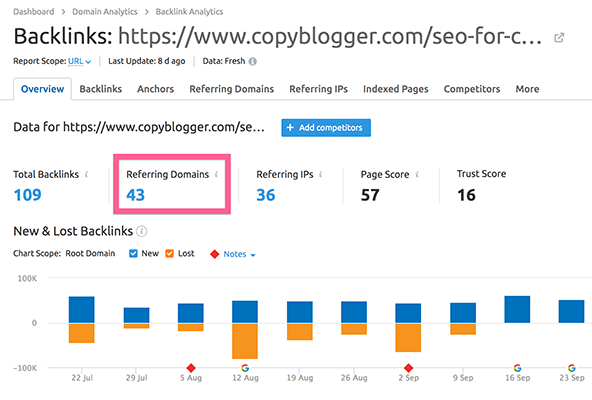
We can also take this a step further by using the SEMrush organic research feature. This will tell us what keywords the page ranks for over time, search volume, competing URL’s, and more.
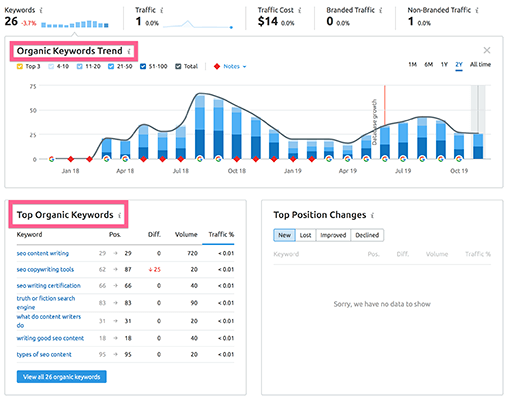
Note: Having access to a competitor research platform like SEMrush can provide a lot of useful insights for content research, a long with plenty of extra tools to level up your content strategy. Click here to try SEMrush for free.
What other platforms does the site distribute its content on?
Be sure to analyze where these websites are distributing their content apart from popular social media platforms.
For example, you can check Reddit by going to “reddit.com/domain/[websitename.com]”
It’s also worth going to any niche social bookmarking platforms to see how the website performs there. For example, since Copyblogger covers marketing related content, we could look at platforms like Growthhackers.com.
Evaluating the website’s media mentions is also critical to understand its success. See if the content is linked or mentioned by a mainstream blog or news outlet, or if it has been shared by influencers.
We can do this easily by digging into the backlinks shown within SEMrush:
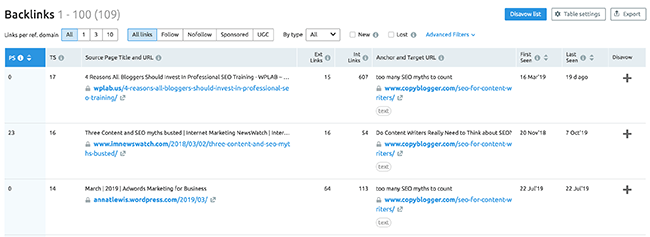
Asking all these questions will help you zero in on what made the content successful. Once you know this, you can reverse engineer the headline, content and distribution to get similar success.
Step #3: Analyze the content and create something better
By now, you should have a pretty good idea of what makes each post from your original list successful.
I like to keep a spreadsheet open with key data about each post. I include headings such as:
- Article URL
- Headline
- Headline analysis (power words + structure such as how-to)
- Length
- Readability
- Visuals used
- Top social platform
- Backlinks
- Referring domains
- Top media mentions
This information would make it easy for me to create a blog post on a different topic.
I’d know what headline structures work, what types of visuals perform well, which social networks to focus on, and which media sites to use for outreach purposes.
This way, I can reverse engineer successful content and nearly guarantee my content success, instead of taking the “spray and pray” approach.
Wrapping it up (and key takeaways…)
We’ve covered a lot of ground, so now let’s look at some key takeaways and an important note on how to proceed.
- We all love original content but it doesn’t always pay off. The best way to succeed is to find what already works, then use its structure, style, and tone to inspire content on a different topic.
- Original content works best when you have an established audience. If you’re just getting started, publish proven content types and topics with your own unique twist.
- Use social media, Google search and niche sharing platforms to find content that is already successful.
- Drill down into each piece of content to see what makes it tick. This includes focusing on headlines, content style/length, distribution channels, and more.
- Use data from this analysis to create proven content that always works.
And, like I mentioned earlier, follow the 80/20 rule to ensure you’re able to experiment with new approaches to content.
Original content sometimes pays off. Sometimes it doesn’t. It’s a gamble.
Remember: you may need to tweak the 80/20 rule as your audience grows. Don’t be afraid to experiment with your content strategy to find what works best for your audience.
Now it’s time to take what you’ve learned and start implementing.
Related reading:
- 40 Different Types Of Content You Can Create For Your Blog
- 60 Blog Post Ideas For Entrepreneurs, Marketers, And Businesses
- How To Promote Your Blog: The Complete Beginner’s Guide
- The Definitive Guide To Growing Your Blog’s Audience
Disclosure: Our content is reader-supported. If you click on certain links we may make a commission.

